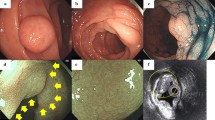Abstract
Psammomatous melanotic schwannoma is an uncommon neoplasm that usually occurs in the setting of Carney’s complex. They can occur in the gastrointestinal tract with preferential location in the stomach. A 43-year-old female presented with two colonic polyps at routine endoscopy. The patient was asymptomatic and did not have features of Carney’s complex. Both polyps were composed of melanin-containing epithelioid and spindle cells with several psammoma bodies. There was no evidence of cytological atypia or necrosis. The tumor was diffusely positive for S-100, and focally for HMB-45 and melan-A. The differential diagnosis includes melanoma, GIST, pigmented neuroendocrine tumor, and epithelioid leiomyoma. The lack of malignant features separates this lesion from melanoma while the immunophenotype of the other lesions is characteristic.






Similar content being viewed by others
References
Carney JA, Gordon H, Carpenter PC, Shenoy BV, Go VL (1985) The complex of myxomas, spotty pigmentation, and endocrine overactivity. Medicine 64:270–283
Carney JA (1990) The psammomatous melanotic schwannoma. A distinctive, heritable tumor with special associations, including cardiac myxoma and the Cushing syndrome. Am J Surg Pathol 14:206–222
Carney JA, Toorkey BC (1991) Ductal adenoma of the breast with tubular features. A probable component of the complex of myxomas, spotty pigmentation, endocrine over activity, and schwannomas. Am J Surg Pathol 15:722–731
Carney JA, Young WF (1992) Primary pigmented nodular adrenocortical disease and its associated conditions. Endocrinologist 2:6–21
Culhaci N, Dikicioglu E, Meteoglu T, Boylu S (2003) Multiple melanotic schwannoma. Ann Diagn Pathol 7:254–258
Daimaru Y, Kido H, Hashimoto H, Enjoji M (1988) Benign schwannoma of the gastrointestinal tract: a clinicopathologic and immunohistochemical study. Human Pathol 19:257–264
Monteagudo C, Ferrandez A, Gonzalez-Devesa M, Llombart-Bosch A (2001) Psammomatous malignant melanoma arising in an intradermal nevus. Histopathology 39:493–497
Miettinen M, Shekitka KM, Sobin LH (2001) Schwannomas of the colon and rectum. A clinicopathologic and immunohistochemical study of 20 cases. Am J Surg Pathol 27:846–855
Prevot S, Bienvenu L, Vaillant JC, de Saint-Maur PP (1999) Benign schwannoma of the digestive tract: a clinicopathologic and immunohistochemical study of five cases, including a case of esophageal tumor. Am J Surg Pathol 23:431–436
Sarlomo-Rikala M, Miettinen M (1995) Gastric schwannoma: clinicopathologic analysis of six cases. Histopathology 27:335–340
Skopelitou AS, Mylonakis EP, Charachanti AV, Kappas AM (1998) Cellular neurilemmoma (schwannoma) of the descending colon mimicking carcinoma: report of a case. Dis Colon Rectum 41:1193–1196
Stratakis CA, Carney JA, Lin J-P, Papanicolaou DA, Karl M, Kastner DL, Pras E, Chrusos GP (1996) Carney complex, a familial multiple neoplasia and lentiginosis syndrome. Analysis of 11 kindreds and linkage to the short arm of chromosome 2. J Clin Invest 97:699–705
Tomozawa S, Masaki T, Matsuda K, Yokoyama T, Ishida T, Muto T (1998) A schwannoma of the cecum: case report and review of the Japanese schwannomas in the large intestine. J Gastroenterol 33:872–875
Veugelers M, Wilkes D, Burton K, McDermott DA, Song Y, Goldstein MM, La Perle K et al (2004) Comparative PRKAR1A genotype-phenotype analyses in humans with Carney complex and prkar1a haploinsufficient mice. Proc Natl Acad Sci 101:4222–4227
Wilkes D, McDermott DA, Basson CT (2005) Clinical phenotypes and molecular genetic mechanisms of Carney complex. Lancet Oncol 6:501–508
Author information
Authors and Affiliations
Corresponding author
Rights and permissions
About this article
Cite this article
Chetty, R., Vajpeyi, R. & Penwick, J.L. Psammomatous melanotic schwannoma presenting as colonic polyps. Virchows Arch 451, 717–720 (2007). https://doi.org/10.1007/s00428-007-0453-0
Received:
Accepted:
Published:
Issue Date:
DOI: https://doi.org/10.1007/s00428-007-0453-0




